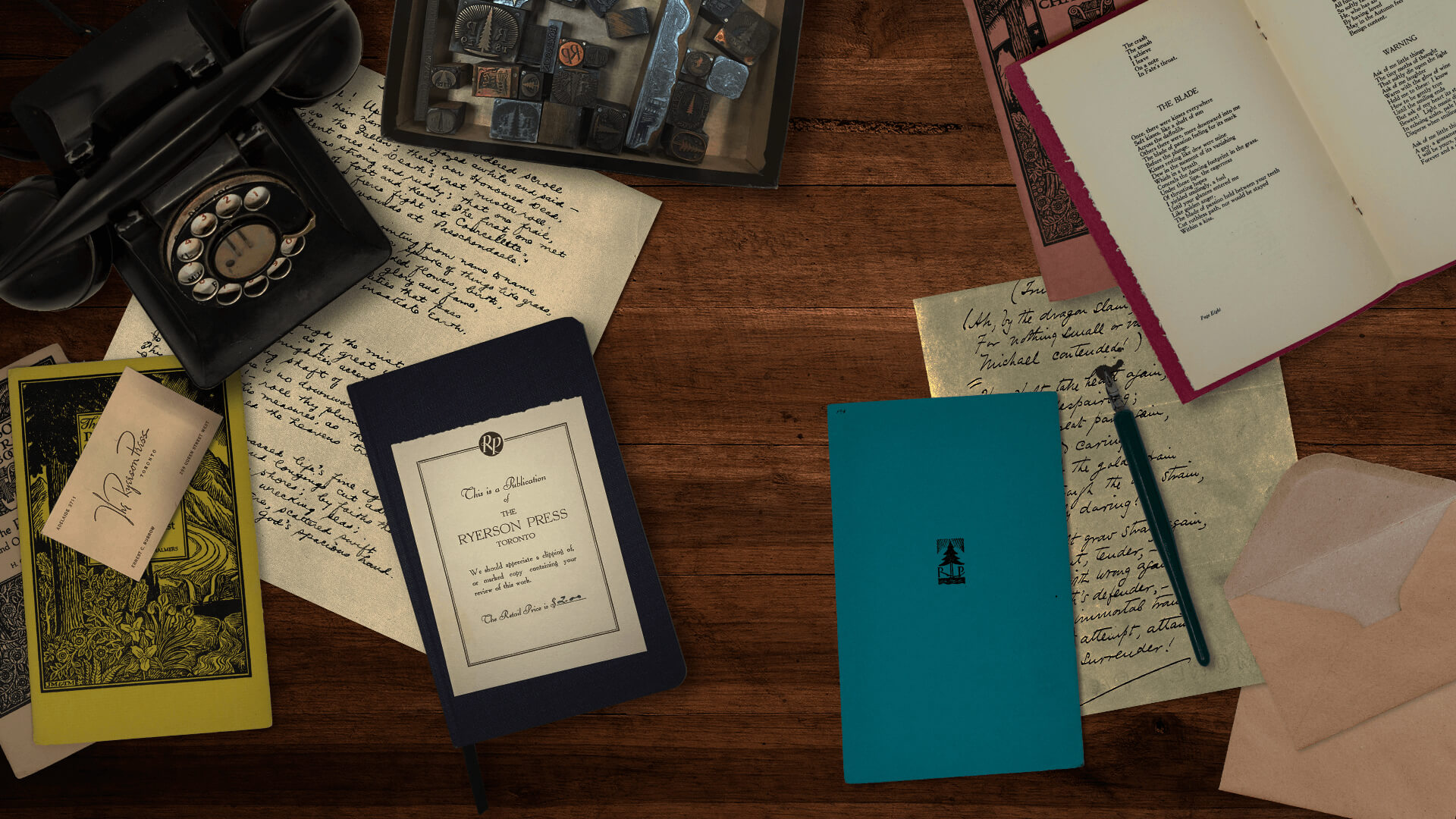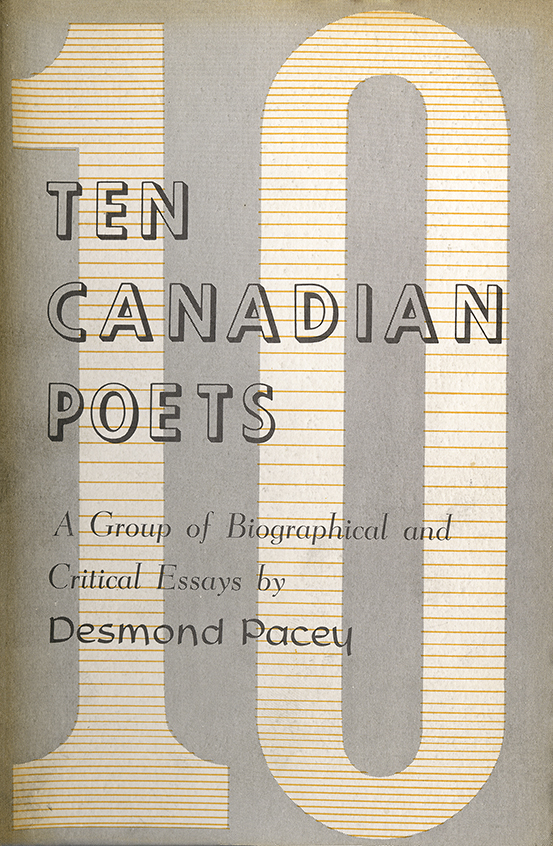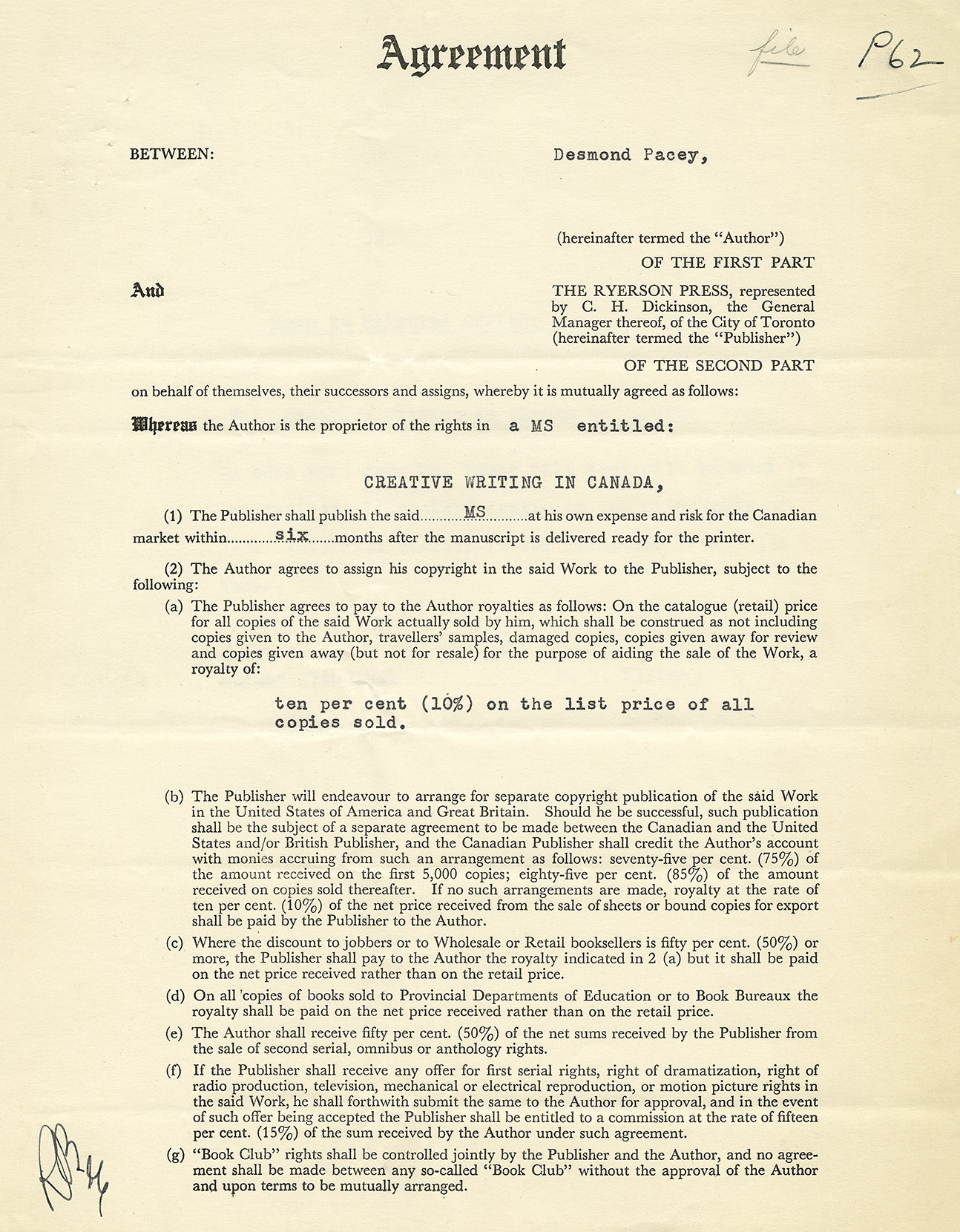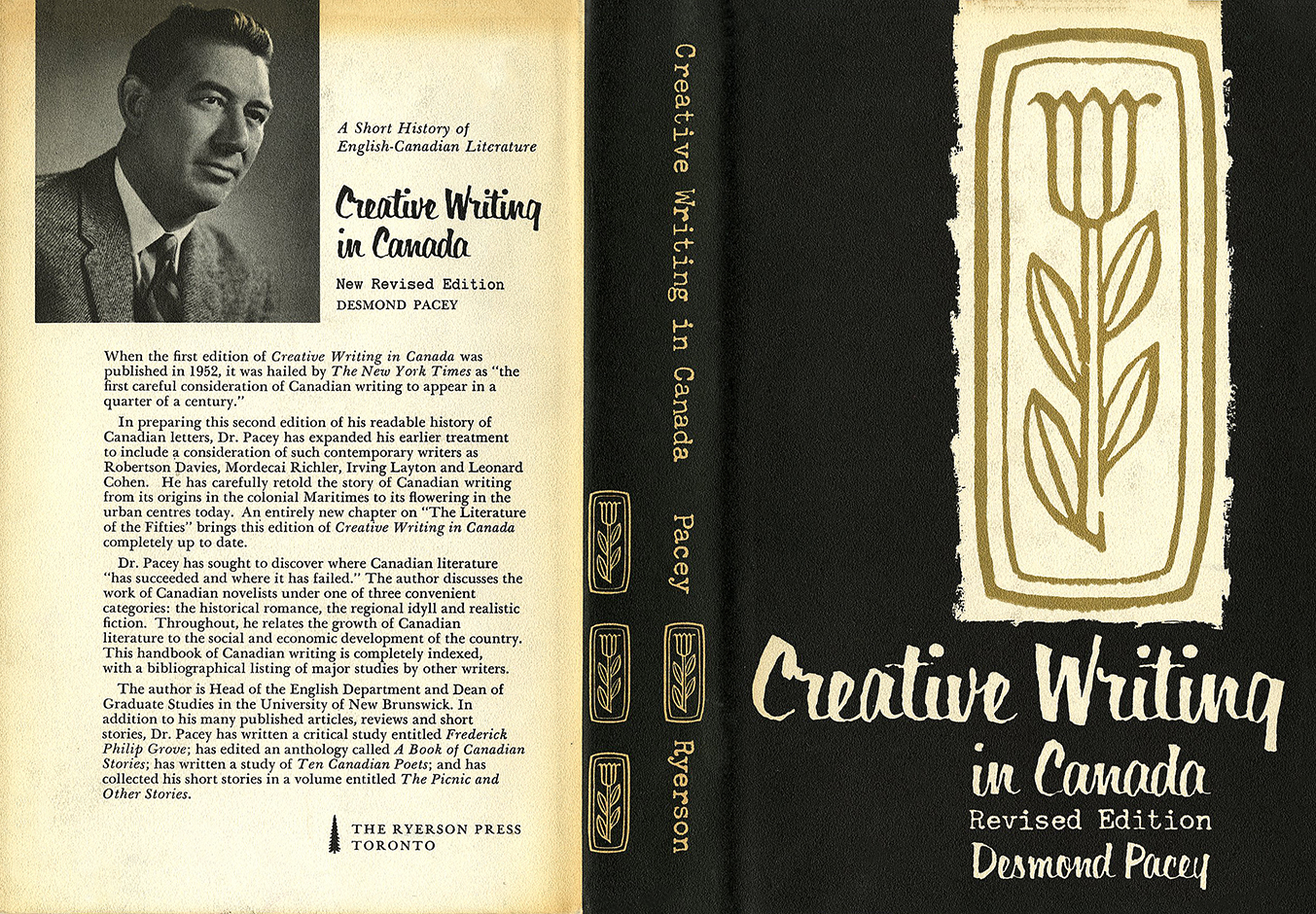Cyril Desmond Pacey, better known as Desmond Pacey (1917-1975), was a professor and writer who is best known as the author of Creative Writing in Canada: A Short History of English-Canadian Literature, published by Ryerson Press in 1952. After the death of his father in the First World War, Pacey moved with his mother first to England and then to Ontario in 1931. From 1934 to 1938, Pacey studied English literature at the University of Toronto. In 1941, he earned a PhD from Trinity College, Cambridge.
In 1940, Pacey began his teaching career at Brandon College (now Brandon University) in Manitoba. He also served as the executive officer and editor of the Wartime Information Board in Ottawa during the Second World War. In 1944, Pacey left Brandon College to chair the English Department at the University of New Brunswick, where he remained until his death in 1975.
At the University of New Brunswick, Pacey had enormous success as an administrator and professor. He was secretary of the faculty from 1952 to 1969. From 1960 to 1970, as dean of graduate studies, Pacey worked to expand graduate education, helping to create the university’s doctoral program in English. In 1970, he became vice-president academic and in 1972-73 served as acting president.1 Pacey went against tradition by pushing the university’s English Department toward greater study and promotion of Canadian literature, which at the time did not receive as much attention as English and American literature, even in Canadian universities. Pacey’s achievements did not go unnoticed. In 1955, he was elected a Fellow of the Royal Society of Canada, and in 1972 was awarded the Society’s Lorne Pierce Medal for his distinguished contribution to Canadian literature. The following year, he was conferred honorary degrees by Mount Allison University and the University of New Brunswick.
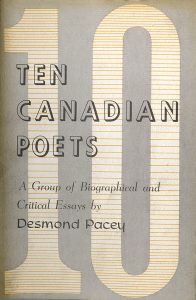
A pioneer of Canadian literary criticism, Pacey was a prolific scholar who promoted and elevated Canadian literature. He authored nine books and edited ten others. Ten Canadian Poets: A Group of Biographical and Critical Essays (Toronto: Ryerson Press, 1958), for example, is a significant volume of literary criticism that proved Pacey’s devotion and contribution to Canadian literature and criticism. He was also co-editor of Our Literary Heritage: An Anthology of Literature in English (Toronto: Ryerson Press, 1966), contributor to ten books, and the author of approximately seventy critical articles.
In addition, Pacey wrote poetry for children and short stories. His verse appeared as The Cow with the Musical Moo, and Other Verse for Children (1952), Hippity Hobo and the Bee and Other Verses for Children (1952), and The Cat, the Cow, and the Kangaroo: The Collected Children’s Verse of Desmond Pacey (1967). His thirty short stories were published in Canada, the US, the UK, France, Germany, Switzerland, and New Zealand;2 they appeared collectively as The Picnic and Other Stories (1958) and Waken, Lords and Ladies Gay: The Selected Stories of Desmond Pacey (1974). Pacey’s prose style was marked by straightforward storytelling and realism, through which he depicted life’s difficulties within an optimistic framework.3
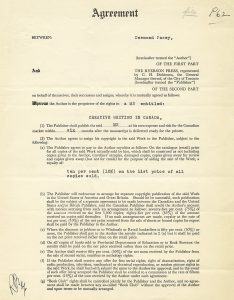
In 1952, Ryerson published Pacey’s influential and sustained critical study, Creative Writing in Canada in an edition of 2460 copies. Fred Cogswell, writing in the Dictionary of Literary Biography, described Creative Writing in Canada as a “work [that] ‘long remained the standard history of Anglophone Canadian literature.’”4 Poets and prose writers of the colonial period, the Confederation era, the early twentieth century, and the modern period were each submitted to Pacey’s straightforward qualitative assessment. As “the first sustained critical effort in decades to present a history of Canadian literature in English,”5 Creative Writing in Canada was regarded as a crucial and decisive text that helped develop concretely the history of English Canadian literature.
Pacey’s work is generally concerned with the social and literary significance of Canadian literature. In grappling with the notion of a lack of Canadian identity and culture, Pacey refutes a 1950 reviewer in the Times Literary Supplement, who declared Canada “a country with no indigenous culture.”6 He argues instead for the distinctiveness of Canadian culture, as found in its literature: “At every stage of its development, Canadian literature has responded to the social, political and physical environment of Canada … Canadian art as a whole, and more particularly Canadian literature, has a distinctive conception of man’s lot on earth, a conception engendered by the particular features of the Canadian terrain.”7 The main purpose, however, of Creative Writing in Canada was not so much to prove that Canadian literature was “distinctive” from other literature published in English. For Pacey, there existed a clear need to establish critically the validity of Canadian literature, to consider the quality of Canadian writing, and “to discover where it has succeeded and where it has failed.”8
Creative Writing in Canada was generally well received, but it was not without its critics, a number of whom were quick to point out that it failed to reference all major literary figures, past and present. In fact, Pacey had anticipated some of the criticism. In the preface to the first edition, he admitted that his selective survey “does not pretend to be exhaustive, but aims rather to single out the most interesting work in each period.”9
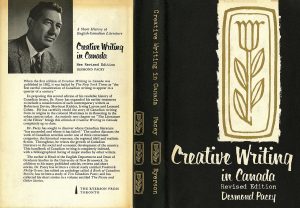
In 1961, Ryerson Press brought out Creative Writing in Canada in a revised, second edition of 5103 copies. In a preface to this volume, Pacey explained that his study was “sufficiently well liked by the Canadian and non-Canadian public to make a second edition necessary.”10 In the second edition, chapters six and seven – Modern Canadian Poetry (1920-1950) and Modern Canadian Fiction (1920-1950) – were revised to include new authors, among them Irving Layton, Robertson Davies, Mordecai Richler, and Leonard Cohen. An eighth chapter entitled The Literature of the Fifties was added, as well. In 1967, Ryerson Press released an affordable paperback issue of the second edition in 4330 copies. Number twenty-one in the Ryerson Paperback series, it was priced at $3.25. The paperback made Pacey’s readable history of Canadian literature – accompanied by a helpful listing of major studies by other critics – more widely available to students of literature.
In 1961, Pacey believed that Canadian writers were secondary figures on the world literary stage and lamented the lack of Canadian authors in the “very first rank.”11 If he were alive today, no doubt Pacey would have a lot to say about the evolving cultural and political landscape that is changing the face of Canadian literature. Certainly, he would appreciate Canada’s Indigenous authors and writers of colour. He would laud the international success of writers such as Alice Munro – Munro was awarded the Nobel Prize in Literature in 2013 – Margaret Atwood, Yann Martel, and Heather O’Neill, to name a select few.
Creative Writing in Canada, which grew out of Pacey’s conviction that Canadian literature was worthy of respect and scholarly attention — a view strongly supported by his publisher — went on to become the standard history of Canadian literature. For its role in fostering a consciousness of Canada’s literary heritage, Creative Writing in Canada remains an invaluable resource for students of Canadian literature and the history of Canadian literary studies.
1 For more on Pacey, see “Biographical Sketch,” UNB Archives 1995. https://lib.unb.ca/archives/finding/pacey/biograph.html.
2 For more on Pacey’s accomplishments, see “W.C. Desmond Pacey, Curriculum Vitae,” UNB Archives 1995. https://lib.unb.ca/archives/finding/pacey/cv.html.
3 One of the critiques of Pacey’s Creative Writing in Canada was that he idealized realism in Canadian literature. See Philip Kokotailo, “Manifold Division: Desmond Pacey’s History of English-Canadian Poetry,” Studies in Canadian Literature 1997. https://journals.lib.unb.ca/index.php/SCL/article/view/8263/9326.
4 “(William) (Cyril) Desmond Pacey,” Contemporary Authors. http://link.galegroup.com/apps/doc/H1000075503/LitRC?u=rpu_main&sid=LitRC&xid=336ae8f1.
5 “Desmond Pacey,” New Brunswick Literary Encyclopedia, St. Thomas University, 2011. http://w3.stu.ca/stu/sites/nble/p/pacey_desmond.html.
6 See Pacey’s general introduction to Creative Writing in Canada: A Short History of English-Canadian Literature, 2nd ed. (Toronto: Ryerson Press, 1961) 1.
7 Pacey, 2nd ed. 2.
8 Pacey, 2nd ed. 3.
9 Pacey, Creative Writing in Canada: A Short History of English-Canadian Literature (Toronto: Ryerson Press, 1952) vii.
10 Pacey, 2nd ed. vi.
11 See Pacey’s conclusion to 2nd ed. 268.
